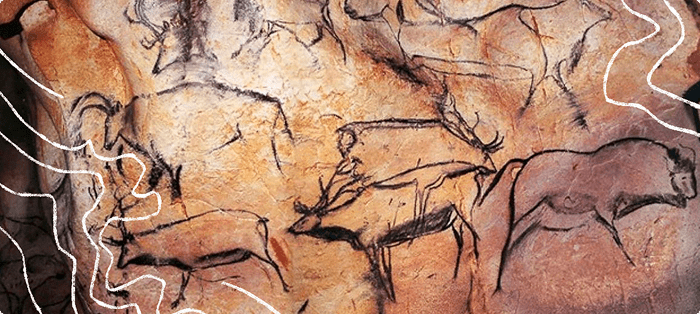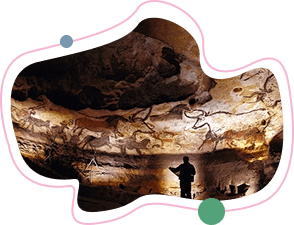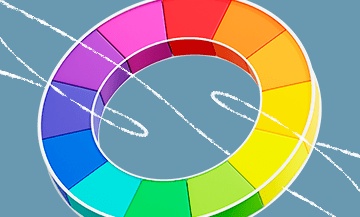Styles in painting are an integral part of humanity’s cultural heritage. They reflect the worldview of a specific time at the most subtle level.
The literal meaning of the term “painting” as a form of visual art serves as proof. The word comes from “live” and “to write.” “Live” means “life,” and “to write” means “to apply paint.” Thus, the essence of painting is to convey living images and emotions using paint on canvas or another surface. Painting allows artists to bring their ideas and perceptions of the world to life, creating works that can evoke a variety of feelings and thoughts in viewers.
The different ways artists have viewed the world throughout human history have given rise to numerous painting styles. Each reflects its time and the unique perspective of the artist. Therefore, it is worth delving deeper into the artistic heritage that has directly influenced our perception of the world.

How painting has changed over the centuries: from drawings on rocks to images on gadget screens





One of the representatives of this period is the Pompeian frescoes, dated to the 1st century BCE and the 1st century CE. They were found in the ruins of Pompeii. These frescoes demonstrate a high level of skill in perspective and chiaroscuro, as well as a variety of themes—from mythological scenes to depictions of everyday life.

With the Renaissance, painting became secular and began gaining popularity with the spread of oil paints, the division of art into genres, and the development of painting styles.
New societal moods and worldviews dictated new approaches to art. Genres such as portraiture and landscape became independent styles. Artists began to express emotions and the inner world of individuals through their work. In the 17th and 18th centuries, as the Catholic Church lost influence, painting began to reflect more secular themes such as everyday life and nature. During the Renaissance, styles such as Baroque, Rococo, Classicism, and Mannerism developed. Later, Romanticism emerged, which was eventually succeeded by Impressionism. In the early 20th century, painting underwent radical changes with the advent of abstract art. Artists sought to convey their emotions and inner world through the harmony of lines and colors, abandoning objectivity. Forms and colors became key elements, and artists enjoyed complete freedom for self-expression. This led to the emergence of avant-garde, underground, and abstract art. Since the late 20th century and into the present, painting has continued to evolve. Contemporary artists often challenge traditional artistic canons and expand the boundaries of subject matter and technique. Modern art places significant emphasis on conceptualism and utilizes new technologies and materials. Artists reflect on social, political, and cultural issues of our time, commenting on topics such as globalization, identity, and the environment.
While painting with AI opens new possibilities for creativity and self-expression, it also raises questions about authorship and the role of technology in the creative process.
Despite new achievements and technologies, many artists remain loyal to classical art, using oil and watercolor paints to create their masterpieces.The most popular painting styles: history and features
Impressionism





Expressionism




Expressionism includes two main directions – “Action Painting” and “Color Field Painting.” “Action Painting” emphasizes the physical act of painting, while “Color Field Painting” focuses on large, simplified forms and flat planes of color.
Jackson Pollock is one of the most famous representatives of Expressionism in the “Action Painting” direction. His “drip” technique, where paint is splattered or dripped onto the canvas, allowed for the creation of unique and chaotic compositions. Pollock’s paintings, such as “Number 1” (1948), became symbols of Expressionism. Mark Rothko is an artist whose works belong to the “Color Field Painting” style. He created large canvases with simple yet powerful color fields, conveying deep emotional states through them. The painting “Untitled (Red on Yellow)” (1956) is a vivid example of his style. Willem de Kooning is another key figure in Expressionism, known for his energetic and dynamic paintings, such as “Woman I” (1950–1952). His works often combined abstraction and figuration. Expressionism had a significant impact on subsequent artistic movements, such as Minimalism and Neo-Expressionism. This painting style changed the perception of art by opening new paths for experimentation and self-expression. Artists gained the freedom to work without the constraints of traditional techniques and subjects, making Expressionism a crucial stage in the development of modern art.Modernism




Neoclassicism




Antonio Canova was an Italian sculptor whose works, such as “Psyche Revived by Cupid’s Kiss” (1787–1793), embody the ideals of Neoclassicism in three-dimensional form. His sculptures are known for their grace and harmony.
Neoclassicism had a significant impact on the development of art and architecture in Europe and America. It became a symbol of rationalism and order, which was particularly in demand during times of political and social change. Neoclassical artists laid the foundations for future generations, demonstrating that art can be not only decorative but also morally significant.Pop Art

Pop Art is an artistic style that emerged in the 1950s and 1960s in Britain and the United States. It is characterized by the use of images and objects from mass culture, such as comics, advertising, and consumer goods. Pop Art artists aimed to challenge traditional notions of art and elevate everyday objects and images to the level of art.
The main characteristics of Pop Art are:

Pop Art draws inspiration from mass culture, including comics, advertising, and consumer goods. Pop Art artists often used images of celebrities and popular products.

Pop Art works are characterized by bright, vibrant colors and clear graphic lines. This gives the pieces a stylish and appealing look.

Pop Art often uses irony and humor to comment on contemporary social and cultural phenomena. Pop Art artists play with viewers’ expectations and create works that entertain while also provoking thought.
Andy Warhol is one of the most famous representatives of Pop Art, renowned for his images of popular products such as Campbell’s Soup cans and portraits of celebrities, including Marilyn Monroe. Warhol also explored the phenomenon of mass production and consumption in his works.
Roy Lichtenstein was an artist known for creating paintings in the comic book style. His works, such as “Whaam!” (1963), use Ben-Day dots and bold outlines to create a recognizable and vibrant visual language.
Claes Oldenburg was an artist and sculptor whose works include large-scale representations of everyday objects like hamburgers and ice cream. His pieces are often made from soft materials, adding a humorous and surreal touch.
Pop Art has had a significant impact on the art world, influencing subsequent movements such as Neo-Pop and Postmodernism. It changed the perceptions of what could be considered art and opened new avenues for artistic expression. Pop Art continues to be an important and influential style, inspiring contemporary artists and designers.
Realism




Romanticism




Post-Impressionism




Cubism



-
- Abstraction.
Picasso believed that Cubism should be an art form that shows the world not as the artist sees it, but as he thinks about it. Cubism becomes a kind of philosophy of painting, attempting to show the true essence of things, rather than their realistic depiction.
However, Cubism was not able to compete with abstract art and became a relatively short-lived phase in the art world of Europe. Its influence can be seen in subsequent movements such as Futurism and Constructivism.Suprematism




Surrealism

Surrealism is an art movement based on the psychological research of Sigmund Freud and the artists’ desire to depict the subconscious.
Key features of Surrealism include:

Surrealist artists aim to depict the world of the subconscious using dreams, fantasies, and allusions.

Surrealists often resort to distorting reality, creating images that cannot be seen in real life.

Many Surrealist techniques are borrowed from Dadaists, who demonstrated the absurdity of life and the existence of the universe.
Salvador Dalí is one of the most famous Surrealists. His works, such as “The Persistence of Memory” (1931), are memorable for their strange and fantastical imagery.
Dalí also worked in Hollywood, creating mystical scenes for films such as “Spellbound” (1945). His collaboration with director Alfred Hitchcock led to the creation of unforgettable visual images filled with Surrealist elements. Dalí aimed to bring his unique vision to cinema, using unusual and often shocking techniques to create an atmosphere of mystery and tension.
René Magritte was an artist known for his realistic paintings that contain elements of the impossible. His work “The Treachery of Images” (1929) is a famous example of Surrealist distortion of reality.
Frida Kahlo was a Mexican artist whose works are deeply personal and autobiographical. Her paintings, such as “The Two Fridas” (1939), reflect her own physical and emotional experiences.
Surrealism has had a significant impact not only on painting but also on cinema, photography, and literature. It continues to inspire artists around the world, opening new ways of depicting the subconscious and the inner world of the human being.
Similarities and differences between styles and influence on each other










The connection between painting and other forms of art
Painting and Literature

Painting and Music

Painting and Theater

Painting and Architecture

Architecture and painting are closely intertwined through the creation of frescoes and monumental murals. Michelangelo in the Sistine Chapel and Raphael in the Vatican Rooms created masterpieces that adorn architectural structures.
During the Modernist era, architects and artists like Antoni Gaudí and Gustav Klimt sought to create cohesive artistic works, integrating painting, sculpture, and architecture into a unified whole.


Thus, painting, literature, music, theater, and architecture mutually enrich and inspire each other, creating a multifaceted and rich cultural space. These art forms, interacting and intertwining, continue to evolve, offering new ways to express and perceive the world.
Question and answer
Determining the most popular style of painting is challenging, as preferences can vary greatly depending on time, place, and context. However, several painting styles are particularly popular and influential:
- Impressionism. This style, which emerged in the late 19th century, gained widespread popularity due to its unique technique and depiction of light and color. Works by artists such as Claude Monet, Edgar Degas, and Pierre-Auguste Renoir remain well-known and beloved today.
- Realism. Realistic art, which aimed for precise representation of reality, has always had a significant number of admirers. Realist artists like Gustave Courbet and Ilya Repin created numerous works that continue to inspire admiration.
- Romanticism. This style, which flourished in the early 19th century, remains popular due to its emotional intensity and dramatic nature. Romantic artists such as William Turner and Francisco Goya created works that still captivate viewers.
- Pop Art. This style, which emerged in the 1950s and 1960s, is still popular for its vibrant and provocative character. Artists like Andy Warhol and Roy Lichtenstein became icons of this movement, and their works continue to influence contemporary art and culture.
- Surrealism. This style, which explores the subconscious and dreams, also has many enthusiasts. The works of Salvador Dalí, René Magritte, and other surrealists attract attention with their strangeness and mystery.
Each of these styles has its unique appeal and resonates with different audiences, making it difficult to pinpoint a single “most popular” style.
- Art Deco, which emerged in the 1920s, is characterized by geometric patterns, bright colors, and luxury.
- Avant-Garde – a movement oriented towards innovation and experimentation in art. The Avant-Garde style in painting encompasses Fauvism, Cubism, Futurism, Expressionism, Dadaism, and Surrealism.
- Cézannism – an art movement based on the creative lessons of French artist Paul Cézanne.
- Fauvism – characterized by a preference for concise, expressive forms and intense color solutions.
- Primitivism – a conscious simplification of form and color, imitating childlike drawings or folk art.
- Academicism – a preference for subjects from ancient mythology, biblical or historical themes over contemporary life subjects.
- Cubism – the deformation and fragmentation of objects into geometric planes, with a plastic shift of form.
- Surrealism – emphasizes absurdity, the unconscious, dreams, and fantasies.
- Futurism – aims to convey the dynamism and speed of the modern world.
- Fantasy painting – depicting mythological and fantastical worlds and creatures.
- Art Nouveau – a style from the turn of the 19th and 20th centuries, emphasizing natural motifs and curved lines.
- Nude painting – a genre focusing on the depiction of the naked human figure.
- Naive art – works created by artists without professional training, characterized by bright and simple imagery.
- Pointillism – a painting technique using dots that form a complete picture from a distance.
- Tachisme – an abstract style characterized by spontaneous patches and splashes of paint on the canvas.
- Orphism – a branch of Cubism focusing on color contrasts and the musicality of composition. These styles represent just a small part of the rich world of painting, each contributing to the development of art.
- Abstract art is characterized by the absence of concrete objects and focuses on shapes, colors and lines. Example: “Composition VII” by Wassily Kandinsky.
- Pop art uses images from popular culture, advertising, and comics. Example: “Marilyn Diptych” by Andy Warhol.
- Minimalism – simple forms and a limited color palette, the pursuit of maximum simplicity. Example: “White on White” by Kazimir Malevich.
- Op art (optical art) creates the illusion of movement and three-dimensionality on a flat surface. Example: “Modular Composition” by Victor Vasarely.
- Hyperrealism is a detailed depiction of reality, often similar to a photograph. Example: “Hyperrealistic Portraiture” by Chuck Close.
- Installation – large-scale works that include a variety of materials and media Example: “Lighthouse” by Olafur Eliasson.
- Street art is art created on the street, which often carries social or political overtones. Example: “Girl with a Balloon” by Banksy.
- Learn the basics. Understanding traditional techniques will help you determine what you like and what suits you.
- Experiment: try different styles, techniques, and materials. Don’t be afraid to step outside your comfort zone.
- Explore the works of different artists and styles. Analyze what you like about their work and why.
- Incorporate personal emotions and thoughts into your work. Your style often reflects your unique perspective and inner world.
- Draw regularly. With experience, you’ll start to notice that certain techniques and approaches become second nature.
- Show your work to others, receive feedback and advice. This will help you see your strengths and weaknesses.
- Analyze your own work. What do you like about it, and what don’t you like? This will help you consciously develop your style.
- Realism, as an aspiration for accurate depiction of reality, with a focus on details and naturalism.
- Impressionism – capturing momentary impressions of a scene, attention to light and color, and use of quick, free brushstrokes.
- Post-Impressionism, as a development of Impressionist ideas with more defined forms and structures, and experiments with color and composition.
- Expressionism – expressing subjective emotions and sensations, often through distorted forms and intense colors.
- Surrealism – blending reality with fantasy, depicting subconscious thoughts and dreams.
- Cubism – breaking down objects into geometric shapes and depicting them from multiple viewpoints simultaneously.
- Abstract art, as a departure from specific forms and subjects, focusing on color, line, and shape to express emotions and ideas.
- Futurism with an emphasis on dynamics, movement, technology, and urbanization, depicting the speed and energy of the modern world.
- Pop art – using images from mass culture and advertising, with bright colors, simple shapes, irony, and comic elements.
- Minimalism – employing simple, clean forms and a limited color palette, with a focus on material and space.



